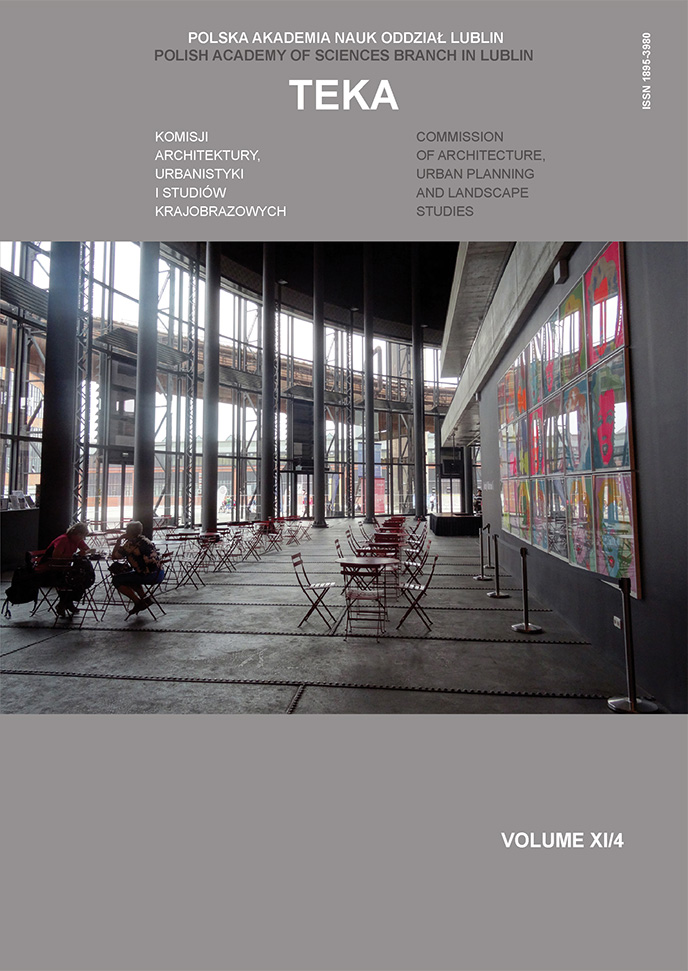Advertisement in art, art in advertisement in context of public space
Article Sidebar
Open full text
Issue Vol. 11 No. 4 (2015)
-
The perception of sacrum in modern architecture
Michał Dmitruk7-14
-
The housing industry in didactics
Agnieszka Kłopotowska, Maciej Kłopotowski15-23
-
Advertisement in art, art in advertisement in context of public space
Agnieszka Chęć-Małyszek24-33
-
Physical space of school – contemporary design indeas
Wojciech Kocki, Jacek Bogucki, Bartłomiej Kwiatkowski34-41
-
Quiet rooms – contemporary design trends
Bartłomiej Kwiatkowski42-48
-
Improving energy performance of a housing estate: assessment of actions taken so far in precast concrete panel blocks of flats
Anna Ostańska, Katarzyna Taracha49-59
-
Library as the heart of a school. The project of Phillips Exeter Academy Library, 1965−72
Marta Pieczara60-67
-
Placemaking de Louis I. Kahn
Marta Pieczara68-77
-
Architectural composition in didactics
Elżbieta Pytlarz78-86
-
Methods of conducting classes on town planning design for the students of architecture in the department of building and architecture at Lublin University of Technology
Marzena Joanna Siestrzewitowska87-99
-
Issues of relativism in the global architecture
Aleksander Serafin100-105
-
Four examples which represent two directions glimpses of polish architecture of the 21st century
Hubert Trammer106-116
-
Testing habitability for sustainable building design
Rolando-Arturo Cubillos-González117-125
-
Methods of creating temporary public spaces
Natalia Przesmycka126-143
Archives
-
Vol. 15 No. 4
2019-12-30 6
-
Vol. 15 No. 3
2019-10-31 9
-
Vol. 15 No. 2
2019-06-28 12
-
Vol. 15 No. 1
2019-03-29 13
-
Vol. 14 No. 3
2018-10-28 14
-
Vol. 14 No. 2
2018-06-29 14
-
Vol. 14 No. 1
2018-03-30 13
-
Vol. 13 No. 4
2017-12-29 8
-
Vol. 13 No. 3
2017-09-29 9
-
Vol. 13 No. 2
2017-06-30 10
-
Vol. 13 No. 1
2017-03-31 10
-
Vol. 12 No. 4
2016-12-30 12
-
Vol. 12 No. 3
2016-09-30 10
-
Vol. 12 No. 2
2016-06-30 9
-
Vol. 12 No. 1
2016-03-31 8
-
Vol. 11 No. 4
2015-12-30 14
-
Vol. 11 No. 3
2015-09-30 7
-
Vol. 11 No. 2
2015-06-30 8
-
Vol. 11 No. 1
2015-03-31 11
Main Article Content
DOI
Authors
Abstract
Formerly the advertisement was a primitive agreement between the producer and the consumer. Since the beginning of the twentieth century advertising spread on a massive scale. The universality of the impact of advertising on human life took on the sociocultural dimension. It is said not only that advertising is changing a person’s life but also that shapes his personality. The purpose of advertising is typically provide information about the product, to convince consumers of its benefits, causing interest and stimulate the desire to have the goods. However, using advertising, be aware of the fact that its dual nature: on the one hand, it has the character of creative arts, on the other hand, in terms of its effectiveness and efficiency impacts. The following article is an attempt to show the fine line between what is considered art has and what is commercialism. It is a representation of the changes that have taken place in the arts, which contributed to blur the boundaries between what is creative and imitative, what is public and what is not.
Keywords:
References
Bażański E., 2004. Kulturowe uwarunkowania percepcji reklamy, Wrocław s. 212.
Brugman J., 2009. Welcome to Urban Revolution. How Cities Are Changing the World, Thomson Press, London s. 231.
Erbel J., K. Herbst, 2011. Sztuka w przestrzeni publicznej. Raport z badania, [w:] Liberated Energy, J. Baranowska, P. Sztarbowski , Warszawa, s. 154−171.
Gehl J., Życie między budynkami. Użytkowanie przestrzeni publicznych, Kraków 2009, s. 9−14.
Golka M., 1993. Rynek sztuki. Warszawa, s. 10.
Mouffe Ch., 2005. Agonistyczne przestrzenie publiczne i polityka demokratyczna, [w:] Krzysztof Wodiczko, Pomnikoterapia, Warszawa, s. 10.
Nawratek, K., 2008. Miasto jako idea polityczna, korporacja ha!art, Kraków, s. 74 oraz s. 260−261.
Nowa Encyklopedia Powszechna PWN, Warszawa, s. 487
Remisko B., 2010. Wizualne zaśmiecanie miast, s. 30−38.
Tomkins C., 2001. Duchamp. Biografia, Poznań, s. 97.
Kuśmierski S., 2000. Reklama jest sztuką, Warszawa, s. 57 oraz s. 90−101.
http://takeme.pl/toread/publikacja/216/Katastrofa_estetyczna_Reklama_w_przestrzeni_publicznej; data odczytu: 21.10.2015 r.
http://www.wiadomosci24.pl/artykul/sztuka_w_reklamie_czy_reklama_w_sztuce_71082.html; data odczytu: 18.11.2015 r.
http://sztuka.dlastudenta.pl/artykul/Pop_art_Sztuka_w_reklamie,104111.html; 11.11.2015 r.
http://www.wykop.pl/ramka/2412236/sztuka-w-reklamie-reklama-w-sztuce/; data odczytu: 11.12.2015 r.
http://marketingwpigulce.pl/sztuka-w-sluzbie-marketingu/; data odczytu: 11.11.2015 r.
http://www.survival.art.pl/, 122 data odczytu; 07.11.2015 r.
Article Details
Abstract views: 453


